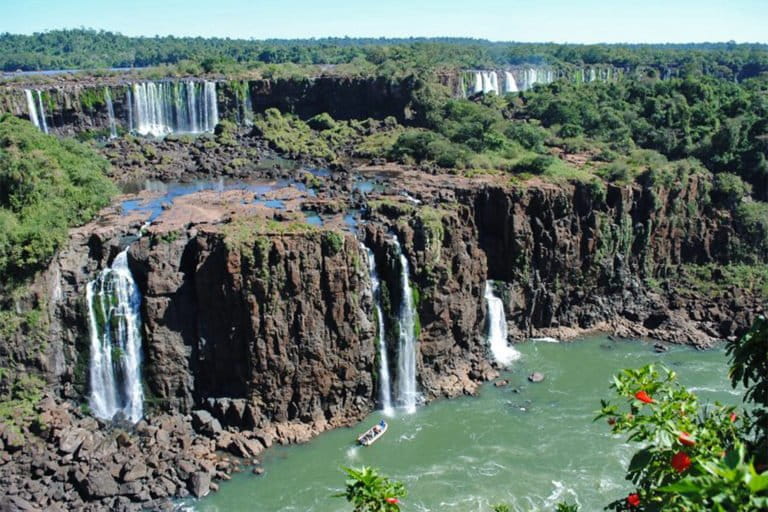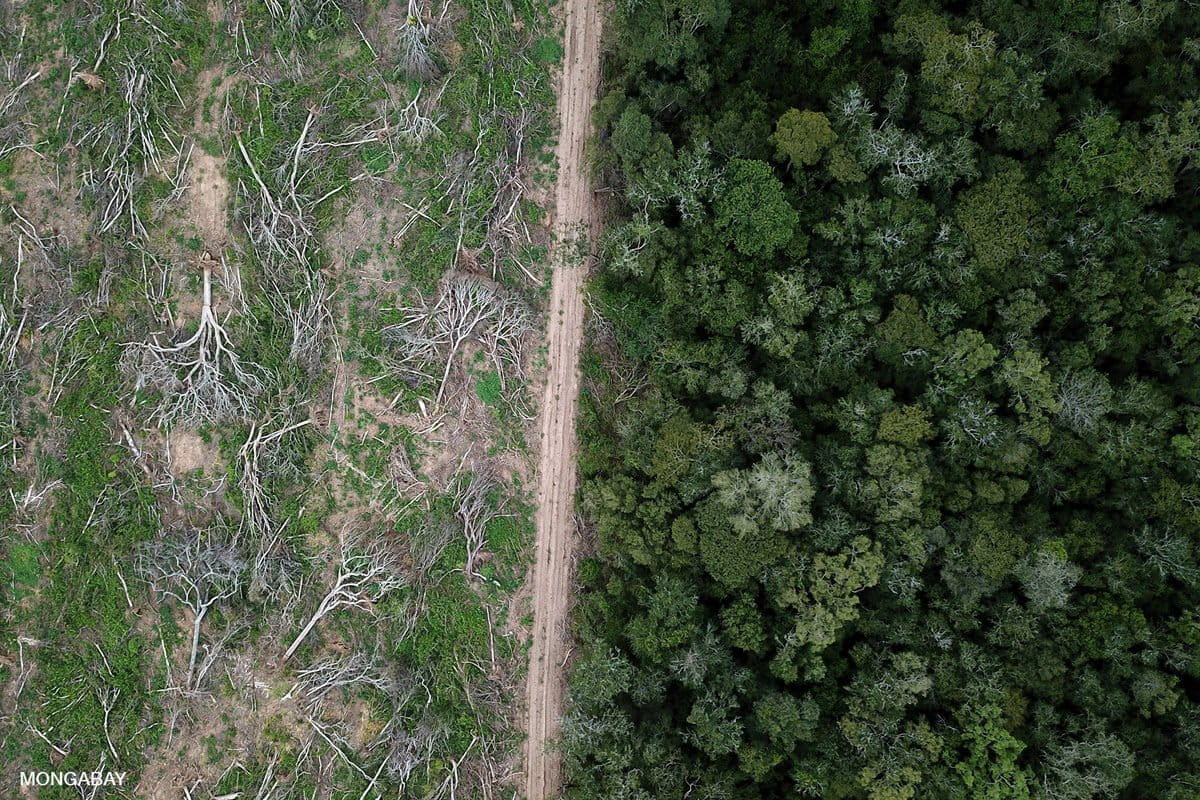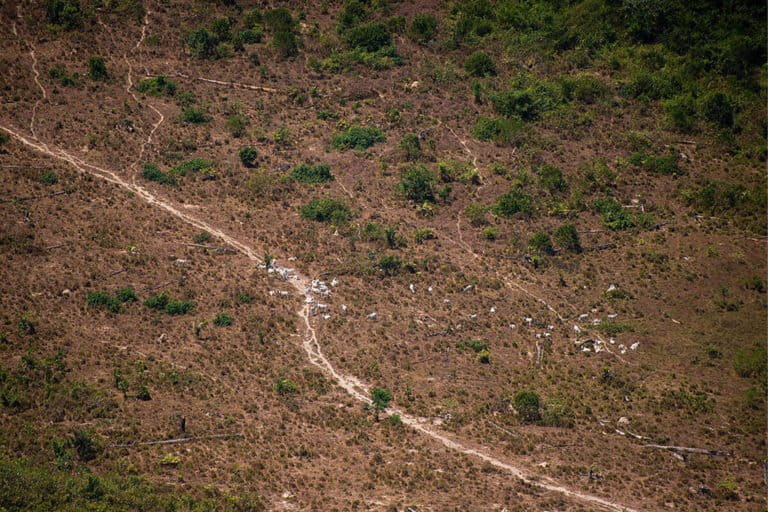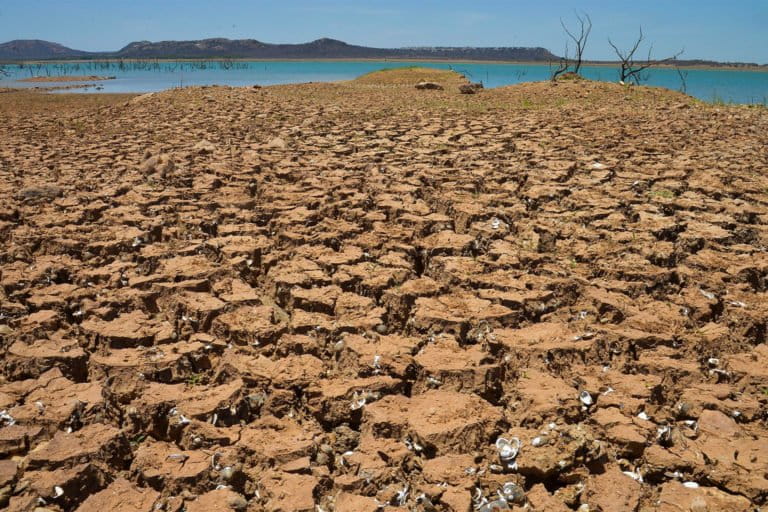- Southern and central Brazil are in the midst of the worst drought in nearly 100 years, with agribusiness exports of coffee and sugar, and the production of hydroelectric power, at grave risk.
- According to researchers, the drought, now in its second year, likely has two main causes: climate change, which tends to make continental interiors both hotter and drier, and the deforestation of the Amazon rainforest and Cerrado savanna biomes.
- Deforestation has caused the loss of almost half of the Cerrado’s native vegetation, which helps hold vast amounts of water underground, maintaining aquifers that supply the nation’s rivers with water. In the Amazon, rainforest loss is preventing billions of tons of water vapor from reaching the atmosphere.
- President Jair Bolsonaro acknowledges neither climate change nor deforestation as sources of the drought, but attributes it instead to the country and himself being “unlucky.” The administration’s drought response so far is to reactivate fossil-fuel power plants, which pollute heavily and are costly to operate.
Central and southern Brazil are facing their worst drought in almost a century, with many of the country’s giant hydroelectric power plants already operating at a fraction of full capacity, agricultural harvest forecasts being scaled down, and fears mounting that Amazon fires will be worse than ever this August. Electricity rationing looms.
For the second year in a row, lack of rain at Iguaçu Falls on the border with Argentina — famous for the huge volume of water plunging over its cliffs — has been transformed into timid trickles.
Farmers say they fear poor harvests of some crops, notably coffee and sugar. “I’ve been growing coffee for more than 50 years, and I’ve never seen as bad a drought as the one last year and this year,” Christina Valle, a third-generation coffee grower in Minas Gerais, Brazil’s biggest coffee-growing state, told The Wall Street Journal. The price of coffee on the world market has reached its highest level in two years.
In early July, the National Water and Sanitation Agency (ANA), Brazil’s water regulator, declared a “critical shortage of water resources,” effective until November, for the vast Paraná River Basin. A third of Brazil’s people live here, many in major urban centers, like São Paulo, the largest city in the Western Hemisphere. It is the basin that both produces and consumes the most hydropower. After flowing through Paraguay and Argentina, these waters stream into the Atlantic via the Río de la Plata estuary.


For the last 12 months, water volume in the Paraná Basin (into which the Iguaçu flows, along with countless other rivers in six states), has been the lowest in half a century. The severity of the drought was recorded in NASA satellite images in mid-June. In the Gran Rosario region of Argentina, the low water level has affected the volume of corn and soy derivatives shipped downriver for export, according to the Rosario Stock Exchange.
ANA’s declaration means that the Brazilian government can now ration water for human consumption or irrigation. Although the mines and energy ministry said in a statement that it is working “incessantly” to avoid rationing electricity, Reuters reports seeing a temporary decree authorizing it.
Two-thirds of Brazil’s electricity is generated by hydroelectric power plants, with stations in the southeast and central-west regions providing more than 70% of that energy. But the drought has drastically reduced water levels in reservoirs, and by early July many stations were operating at 29% of capacity.
Brazilian President Jair Bolsonaro has recognized the scale of the emergency, though not its cause. “We are living through the worst water shortage in our history,” he said. He attributed the crisis to fate: “It’s going to give us a real headache this lack of rain. We’ve been really unlucky.”
Many experts say the president’s explanation is insufficient. While part of the severity of this year’s drought may be linked to La Niña, a periodic upwelling of unusually cold water to the ocean surface along the western coast of South America, this is not the only cause, they say. “It’s a lazy response to attribute the variation in reservoirs only to El Niño [an upwelling of unusually warm water] or La Niña,” geographer Yuri Salmona, a doctoral student in forestry sciences at the University of Brasilia (UnB), told BBC Brasil.

Most scientists point to global warming as an underlying cause of the intense drought. For a long while policymakers in Brazil’s electricity sector refused to factor climate change into their plans, but recently this has begun to change. Luiz Carlos Ciocchi, director-general of the National Electricity Grid Operators (ONS), told O Globo newspaper: “Finally the penny has dropped for the electricity sector and we now understand that we must take global warming and climate change into our appraisals.”
But global warming is not the only major contributing factor. Many scientists say, and studies show, that extensive and ongoing deforestation in the Cerrado savanna and Amazon rainforest biomes plays a key role. “Deforestation and global warming act together and feed off each other,” Márcio Astrini, executive secretary of the Observatório do Clima, a network of civil organizations, told El País.
Cerrado deforestation: A threat to water supplies
According to MapBiomas, an internet platform that monitors Brazilian land use, almost half (43.7%) of the Cerrado’s native vegetation has already been destroyed due to a rapid expansion of agribusiness in the region over recent decades. The pace of deforestation there continues to gain momentum: 7,300 square kilometers (2,818 square miles) of savanna were lost last year, an increase of 12.3% compared with 2019. And that native vegetation loss, say researchers, is impacting the nation’s water supply.
Eight of Brazil’s river basins rise in the Cerrado, known as the “birthplace of waters.” And the biome’s native vegetation plays a fundamental role in the way those rivers provide the whole country with a sufficient water supply. Native vegetation, especially grasses, have deep roots, allowing plants and animals to survive during the dry season, reducing erosion, and holding vast volumes of water below ground. That’s why this region is able to replenish its water tables, aquifers and rivers with each new rainy season.

But when native vegetation is replaced by crops such as soy, corn or cotton, this underground water-storing capacity is disrupted. “Instead of going to an underground deposit to be released to the surface throughout the year, the water flows directly into rivers in the rainy season,” explains Salmona. This increases the risk of severe floods in the wet season and of extensive droughts in the dry season.
Meanwhile, irrigation, which is increasingly being introduced to the increasingly dry Cerrado, is lowering water levels in depleted aquifers yet further. But some government officials, particularly in the agriculture ministry, seem oblivious to the danger.
Agriculture Minister Tereza Cristina says agribusiness can only go on being Brazil’s engine of economic growth if irrigation is greatly increased (even though it already accounts for almost half of Brazil’s water consumption, according to an ANA report).
In June, Cristina declared: “The expansion of irrigated land needs to be seen as a strategic tool for increasing productivity.” She added “We have 3% of agricultural production irrigated, while the world average is 20%,” indicating her ministry wants more irrigation as a hedge against drought.
But Saloma says increasing irrigation without proper controls is a very risky strategy. He says Brazil urgently needs a detailed map of where springs rise and where aquifers are refilled. Failure to take basic cautionary measures, including protecting native vegetation and guarding aquifers, could lead to an escalating spiral of droughts.

Amazon deforestation: A threat to the rainforest’s ‘flying rivers’
The way deforestation in the Amazon is exacerbating drought is different from in the Cerrado, but no less serious.
Oddly, at the moment, as parts of Brazil are suffering from severe drought, Amazonas state is suffering from severe flooding. The Negro River has risen by an extraordinary 30 meters (nearly 100 feet), washing away some small patches of subsistence agriculture carried out by traditional communities for perhaps centuries, and threatening food security.
Despite these extreme precipitation events in northern Brazil, many scientists maintain that changes in the Amazon region’s climate are helping drive the drought in the south of the country and may eventually accelerate the “savannization” of the Amazon.
A few decades ago, a group of scientists came forward with a novel explanation of the role the Amazon River plays in providing rain to the whole of the Southern Cone (as south Brazil, Argentina, Uruguay and Paraguay are known), though their views and evidence are still contested in a few quarters.
These scientists estimate that the Amazon rainforest pumps billions of tons of water vapor each day into the atmosphere via transpiration and evaporation, moisture that becomes “flying rivers,” which prevailing trade winds move from east to west. When these flying rivers meet the Andes, they drop some of that moisture on the eastern slopes of the mountain range, forming the headwaters of Amazonian rivers. However, barred by the high mountains (averaging nearly 4,000 meters, or 13,000 feet high), the flying rivers (still carrying much water vapor), veer south and also southeast, heading toward central and southern Brazil, where that moisture falls as rain.
But, of course, that is the region now suffering terrible drought. The reason could be, say scientists, that if you cut huge swaths of rainforest, replacing it with cattle pasture and soy plantation, then the flying rivers diminish or cease their flow.

In 2014, climate researcher Antonio Nobre with Brazil’s National Institute for Space Research (INPE) published a report, titled “The Future Climate of the Amazon.” Nobre described the link between deforestation, the weakening of flying rivers, and reduced rainfall. He warned that Brazil must stop cutting down the Amazon forest and, if it didn’t, deforestation could generate a “dramatically inhospitable” climate impacting agribusiness, water supplies, and hydropower.
His and other evidence have caused scientists to repeatedly call for “zero deforestation” in the Amazon. But the opposite is happening. This year, Amazon deforestation rose for the fourth consecutive month in June, according to INPE. Altogether, deforestation increased by 17% in the first six months of 2021, with the clearing of 3,610 km2 (1,394 mi2), an area more than four times the size of New York City.
“The predictions I made are all, unfortunately, coming true,” Nobre told Mongabay.

Fear of record fires
One needn’t look far for the catalyst that’s escalating Amazon deforestation. Emboldened by Bolsonaro’s incendiary rhetoric and lax environmental policies, land grabbers and cattle ranchers have been clearing rainforest at a fast pace. In a joint study, the not-for-profit Amazon Environmental Research Institute (IPAM), and the Woodwell Climate Research Center found that 5,000 km2 (1,900 mi2) of forest has been cut, and the downed wood dried out, over the last few years, and is just waiting to be set alight by those clearing the land, many of them land thieves.
Although the fire season is only just beginning, both the Amazon and Cerrado recorded a high number of fires in June; the Amazon saw the highest number in 14 years while the Cerrado saw the highest in 11 years. Worse may lay ahead.
“Knowing that there is this amount of firewood waiting to be burnt should be enough to get the government to take action in the field to curb the fires,” said Paulo Moutinho, an IPAM senior researcher. Indeed, at the end of June, the government issued a nationwide ban on fires. It did the same last year, but with no perceivable practical effect: there were 15% more fires in the Amazon in 2020 than in 2019, according to INPE.
There is little to suggest it will be different this year, especially with the nation’s environmental agency, IBAMA, largely defunded and deactivated by the Bolsonaro administration.

Dealing with the energy shortage
Faced with the drought-initiated energy crisis, the government is resurrecting fossil-fueled power plants, where water is heated into steam, by burning coal or diesel, to drive an electrical generator and then cooled.
However, such plants are dirty and expensive to operate, and also use large volumes of water. Astrini told El Pais: “During the cooling process, these stations, alone, use as much water as whole municipalities.”
Experts say there are better alternatives. “A more logical and cheaper option than turning to the thermal plants would be to have more renewable energy entering the system, mainly wind and solar,” said Donato da Silva Filho, director of consultancy with Volt Robotics. Neither eco-friendly alternative requires water.
In the longer term, Brazil faces seemingly incompatible goals: How can it remain one of the world’s leading exporters of agribusiness commodities and achieve national economic growth, while not disrupting the country’s rain-producing climate patterns vital to agriculture, not exacerbating global climate change, preventing widespread Amazon fires, and still providing sufficient electricity and food for the country’s people?

The first sensible step might be an honest evaluation of the problems and the science, and an open discussion of options. But hope of such a forum has faded with each ensuing presidential administration — from Dilma Rousseff to Michel Temer, and now Jair Bolsonaro.
Brazil is much like Earth’s other nations: Now facing the potentially disastrous repercussions of past “business as usual” activities, while also confronting looming, increasingly more daunting, challenges to avoid a catastrophic future. The very survival of Brazil — and humanity — may depend on how these conundrums are resolved.
Note: On July 21, 2021, an image showing tractors plowing a field in Brazil was replaced with an image showing deforestation for soy adjacent to forest.
Banner image: Fields irrigated by center pivot, Goais, Brazil. The increase in irrigation in dry Cerrado is lowering water levels in depleted aquifers further. Image by Hervé Théry/Water Alternatives Photos via Flickr (CC BY-NC 2.0).
FEEDBACK: Use this form to send a message to the author of this post. If you want to post a public comment, you can do that at the bottom of the page.
